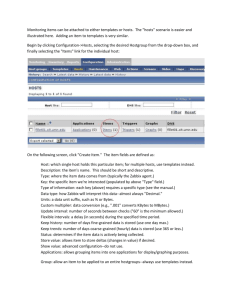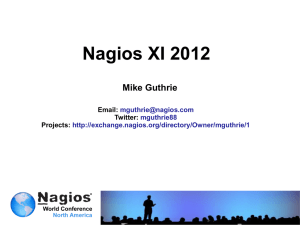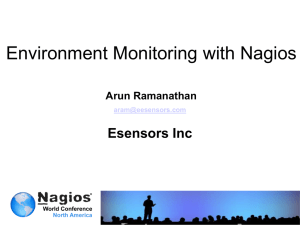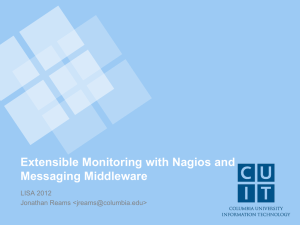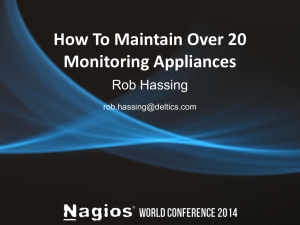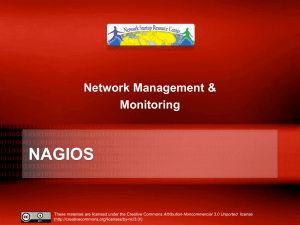Nagios and Kentix System Partners
advertisement
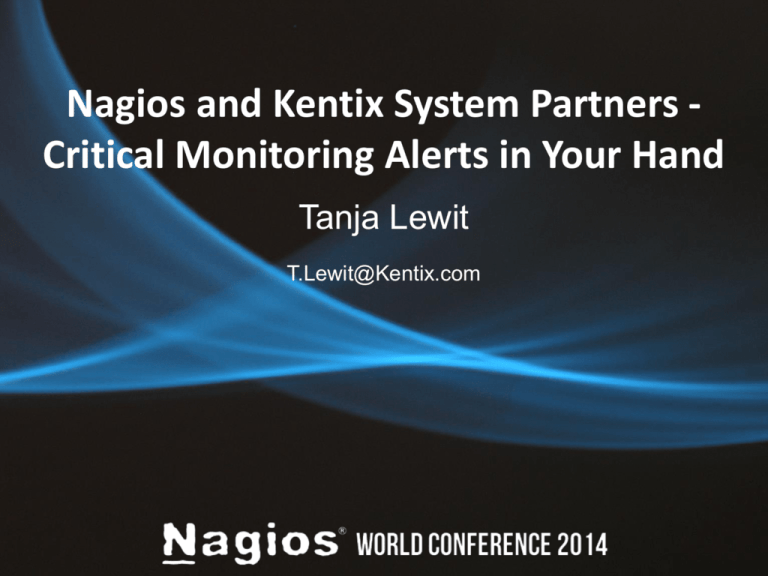
Nagios and Kentix System Partners Critical Monitoring Alerts in Your Hand
Tanja Lewit
T.Lewit@Kentix.com
Introduction & Agenda
• Nagios Core is the industry standard, Open
Source IT monitoring system that enables
organizations to identify and resolve IT
infrastructure problems before they affect
critical business processes.
• Kentix is a one box “Lego Block” that adds
physical environmental monitoring and
security as an extension .
Nagios and Kentix as “Partners”
With Kentix and Nagios integration ANY monitored parameter
can be established as an “alert” and can be sent via text or
email to your phone.
We will cover:
>Nagios Setup for monitoring Kentix Alarm Manager-PRO
with connected MultiSensors
>Setting up Nagios SMS-Alarming and Email notification via
Alarm Manager
Why Physical Monitoring
One Box Innovative Security
Kentix was developed to ensure Critical Equipment
protection. We feature Multi-Sensor technology which
provides for all environmental sensing parameters in one.
Temp, humidity, dew point, CO2 , Pre-alarm for Fire,
Motion, Access, Sabotage, Power Loss , etc .
The IT server room is a critical equipment area and
beyond the network and processes, security and
reliability of uptime means making sure the equipment
Is protected.
Multi-Sensor Technology
Nagios Core Overview
Comprehensive Monitoring: Provides monitoring of
all mission-critical infrastructure components including applications, services, operating systems,
network protocols, system metrics, and network
infrastructure.
Visibility: Provides central view of your entire IT
operations network and business processes.
Nagios Core Benefits
Awareness: Alerts are delivered to IT staff via email and SMS. Multiuser notification escalation capabilities ensure alerts reach the
attention of the right people.
Problem Remediation: Event handlers allow you to automatically
restart failed applications, services, servers, and devices when
problems are detected.
Reports: Ensure SLAs are being met, provides historical records of
outages, notifications, and alert response for later analysis.
Extendable Architecture: Provides easy integration with in-house and
third-party applications. Hundreds of community-developed add-ons
extend core functionality.
The Partners
Nagios Setup for monitoring Kentix Alarm Manager-PRO with
connected MultiSensors
System Requirements
- Installed Nagios Core with SNMP-Plugins / Nagios-Plugins
- Installed and configured E-Mail-Server (i.e. Outlook)
The configuration is done by editing the Nagios config-files manually.
A configuration with a GUI (Graphical User Interface), i.e. NagiosQL is
also possible but it has to be installed separately.
The path of the Nagios installation and its config files can vary
depending on the way of installation (packages/source).
The files that require modification are always the same.
For this example -the Nagios installation was built from its source
Kentix-Knowledge Base
* Edit the main Nagios config file (nagios.cfg):
nano /usr/local/nagios/etc/nagios.cfg
* Locate the line „check_external_command=0“ and
* Activate: "check_external_command = 1"
* Locate the „OBJECT CONFIGURATION FILES section“
* Add the config files:
cfg_file=/usr/local/nagios/etc/objects/commands.cfg
cfg_file=/usr/local/nagios/etc/objects/hosts.cfg
cfg_file=/usr/local/nagios/etc/objects/services.cfg
cfg_file=/usr/local/nagios/etc/objects/contacts.cfg
Kentix Knowledge Base
* Paths can vary between distributions and installation
variant (packages/built from source)
• Create the defined config files if these do not already exist
touch /usr/local/nagios/etc/objects/commands.cfg
touch /usr/local/nagios/etc/objects/hosts.cfg
touch /usr/local/nagios/etc/objects/services.cfg
touch /usr/local/nagios/etc/objects/contacts.cfg
Kentix Knowledge Base
*Add the AlarmManager to the monitored hosts
*Edit the hosts configuration file
nano /usr/local/nagios/etc/objects/hosts.cfg
*Insert the AlarmManager as a new host to check in Nagios.
define host {
! use! ! ! ! generic-host
! host_name ! ! ! AlarmManager
! alias ! ! ! ! AlarmManager
! address ! ! ! 192.168.1.1
! check_command ! ! check-host-alive
! max_check_attempts ! 10
! notification_interval ! ! 60
! notification_period ! ! 24x7
! notification_options ! ! d,u,r
*Restart Nagios
/etc/init.d/nagios restart
The AlarmManager will now appear in the hosts section of the Nagios web
interface..
Adding an SNMP check for 1
MultiSensor value
* Download the file Kampro.mib (SNMP MIB in the software section on
www.kentix.com) and open in a MIB Browser (i.e. iReasoning MIB Browser) to
determine the OIDs for e.g. the temperature of MultiSensor 1.
Note Itʻs also possible to use snmpwalk to catch the needed OID.
snmpwalk -v2c -c private IP .1.3.6.1.4.1.37954
*Edit the commands configuration file nano
/usr/local/nagios/etc/objects/commands.cfg
*Insert / modify the following command definition:
# 'check_snmp' command definition
define command{
command_name ! check_snmp
command_line ! ! $USER1$/check_snmp -H $HOSTADDRESS$ -c $ARG1$ -o $ARG2$ -c
$ARG3$
}
Adding an SNMP check for 1
MultiSensor value
Description of the arguments:
$ARG1$ = SNMP Community
$ARG2$ = OID
$ARG3$ = critical warning range (also possible in 2 levels with -w (warning) and -c
(critical))
Edit the services configuration file
nano /usr/local/nagios/etc/objects/services.cfg
Insert the following service definition:
define service{
! use ! ! ! generic-service
! host_name ! ! AlarmManager
! service_description ! Sensor 1 Temperature
! check_command check_snmp!IP-of-AlarmManager!public
!.1.3.6.1.4.1.37954.1.2.1.2.0!100:300
}
Adding an SNMP check for 1
MultiSensor value
Arguments are separated with "!"
!100:300 means warn and alert below 10 degrees and
above 30 degrees.
Restart Nagios
/etc/init.d/nagios restart
The Sensor will now appear in the Services section and
update its value after a short time
Setting up Nagios E-Mail notification and SMS-Alarming
via AlarmManager
ROUND TWOEdit the hosts configuration file
nano /usr/local/nagios/etc/objects/hosts.cfg
Add a contact or contact group to your AlarmManager-host for the alarming.
...
contacts nagiosadmin
..
Edit the contacts configuration file
nano /usr/local/nagios/etc/objects/contacts.cfg
Create a new contact
define contact{
contact_name nagiosadmin ! ; Short name of user
use generic-contact ! ; Inherit default values from generic-contact template
alias Administrator! ! ; Full name of user
service_notifications_enabled! 1! ;
service_notification_period ! 24x7 ;
host_notification_period ! 24x7 ;
service_notification_options ! w,u,c,r,f ;
host_notification_options ! d,u,r,f ;
service_notification_commands ! notify-service-by-email, otify-by-sms-service ;
host_notification_commands ! notify-host-by-email,notify-by-sms-host ;
pager ! ! +9736005170 ;
email mail@address.com ; <<** CHANGE THIS TO YOUR EMAIL ADDRESS
**
}
Edit-Locate
Edit the commands configuration file
nano
/usr/local/nagios/etc/objects/commands.cfg
Locate the following sections.
# 'notify-host-by-email' command definition
# 'notify-service-by-email' command definition
In the command_line of these two command
definitions update the mailer behind the pipe to
your used mailing-command (e.g. „/usr/bin/mail“ ).
Insert Command Definition
Insert the following command definition for SMS sending:
define command {
command_name notify-by-sms-host
command_line $USER1$/NagiosSendSMS.pl nagiosadmin kentix
$CONTACTPAGER$ "Device:
$HOSTNAME$, Description: $HOSTSTATE$, $HOSTOUTPUT$"
}
define command {
command_name notify-by-sms-service
command_line $USER1$/NagiosSendSMS.pl nagiosadmin kentix
$CONTACTPAGER$ "Device:
$HOSTNAME$, Description: $SERVICEDESC$, $SERVICEOUTPUT$"
}
Note:
nagiosadmin! is the user that has
to exist in your AlarmManager
configuration
“kentix" is the Web User Password
of the AlarmManager-user
We recommend a separate user
with only User name and Web
User Password for SMS-Gateway
alarming.
Copy the Perl-Script-File „NagiosSendSMS.pl“ that
comes with the SNMP MIB archive download into the
folder of your Nagios Plugins
(/usr/local/nagios/libexec).
Edit the Script-File:
nano /libexec/NagiosSendSMS.pl
In line #32 change the IP-address to your
AlarmManager-IP.
Modify the file-owner to your nagios user (chown) and
make it executable (chmod +x).
Restart Nagios
/etc/init.d/nagios restart
E-Mail and SMS-Notification will now work for the
AlarmManager host and its defined services.
To test both ways of notification, set one of the values
in your services configuration file (services.cfg) to a
critical level, and restart nagios again.
After 3 attempts you will receive your notification
Screen Shot
Screen Shot
Can you repeat that?
Have no fear!!
All information available on the web
www.Kentix.com
http://kentix.com/us/?page=service_knowledge
-base
And always dedicated support
1-844-KENTIX2
Conclusion
Its about securing and monitoring mission critical applications and
equipment.
Nagios- Is The Industry Standard In IT Infrastructure Monitoring
Plus +
the Innovative system that Detects all physical risks - instant alerting
- ingeniously simple to ensure the Environment and Equipment are
monitored and secure
Achieve instant awareness of IT infrastructure and the critical
environment of any problems, so downtime doesn't adversely affect
your business.
Questions?
Any questions?
The End
Presenter
t.lewit@kentix.com
